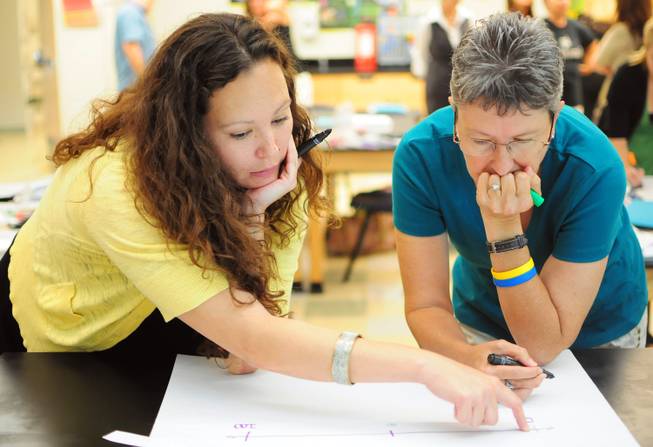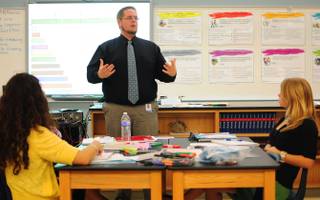
From left, Clark County School District teachers Christine Pesqueira and Cheri Grossman participate in a summer training session on Tuesday, July 24, 2012. More than 5,000 teachers are taking unprecedented professional development opportunities over the summer in a district-wide initiative to boost student achievement in the upcoming school year.
Thursday, July 26, 2012 | 2 a.m.
Sun coverage
Standing in front of a classroom, Kris Huffman launches into a lesson on fractions.
A lesson on how to teach fractions, that is.
That’s because Huffman isn’t teaching his regular group of students: dozens of children attending Tom William Elementary School in North Las Vegas.
On this hot summer day, Huffman’s “students” are 20 Clark County School District teachers who have given up part of their three-month vacation to attend a math camp for educators.
Feel free to call it a sort of summer school for teachers.
Using a mix of traditional and modern tools to engage students, Huffman is aiming to cultivate a new breed of math teachers who can boost the School District’s lagging academic achievement in the fourth and fifth grades.
“The expectations of our students have increased, so the demands on our teachers have increased,” Huffman said. “This is a great opportunity to show teachers they are lifelong learners.”
This new professional development program is part of an unprecedented push by the School District to train teachers in instituting a more rigorous curriculum and to incorporate new technology into the classroom. More than 5,000 teachers — a little more than a quarter of all teachers — are taking part in the monthlong program made available to them for the first time this summer.
“I would like to thank each one of our teachers who spent a portion of their summer working to improve their skills in preparation for the state of the new school year,” Clark County Schools Superintendent Dwight Jones said in a statement. “Increasing the knowledge and abilities of our teachers is an important component of growing academic achievement for CCSD’s students.”
The training sessions were open primarily to teachers from Title I schools, which serve high numbers of students from minority and low-income backgrounds. A record 224 schools — about 63 percent of the district’s 357 schools — are now classified as Title I schools so they would be eligible to receive federal Title I grant funding to put into place programs such as professional development over the summer, district officials said earlier this month.
Teachers can take four-day sessions in more than 90 different professional development courses — each about 24 hours long — in a variety of subjects from science and math to English, foreign language, technology, and gifted and talented education.
Participants and instructors were paid $30 an hour, which came out of Title I dollars with no impact to the cash-strapped district’s general fund, said Karen Schiemer, K-fifth-grade mathematics coordinator for the School District.
On average, teachers take between five and seven days of professional development each year, often to fulfill teaching credits to maintain their licensure, Schiemer said. These trainings — sometimes free, other times not — often take teachers away from their students, cutting into valuable instruction time, she said.
“The goal is for teachers to remain in the classroom during the school year,” Schiemer said. “Teachers are eager to learn. They don’t mind giving up part of their summertime to learn new ways to engage students.”
One way teachers are now trying to engage students is through new technologies, such as smartboards and tablet computers, Huffman said. His recent summer training included a discussion on how to incorporate a digital chalkboard into a lesson plan on fractions.
For decades, teachers have used Cuisenaire rods, plastic building blocks used to teach fractional units. With the advent of smartboards and digital projectors, teachers are now incorporating more high-tech methods to teach fractions, Huffman said.
“Students are exposed to technology in so many aspects of their lives,” he said, adding that many Title I-funded schools have used some grant money to purchase smartboards. “It’s important for them to interact with technology in the classroom.”
Mike Jones, who taught at William Elementary with Huffman last year, said he saw benefits to both the traditional and modern ways to teach fractions.
Cuisenaire rods allow students to work in small groups to learn about fractions but could cause students to become easily distracted, Jones said. A smartboard can allow teachers to engage students in fractions as an entire class, he said.
However, the traditional plastic rods have their own merits, Jones said.
“The Cuisenaire rods are still superior when you introduce fractions,” Jones said. “It’s more tactile. Students still need to be able to use all their senses — physically touch ‘manipulatives’ — to grasp concepts.”
Although the smartboards allow teachers to use special sounds and animations to grab students’ attention, it’s still quite “conceptual,” Jones added.
However, that might work to students’ advantage, Sciemer said.
The summer trainings also help teachers begin to incorporate into their curricula a new set of Common Core standards, Schiemer said. All but five states have adopted these more rigorous academic standards, which stress that students learn the concepts behind math and science instead of just rote memorization of facts.
Once the Common Core standards are fully instituted in the 2014-15 school year, students will be asked to defend and explain their answers to gauge whether they actually understood the math, Schiemer said.
The summer training helps educators teach differently, she added.
“We want to teach students that problems don’t have to be solved in one way,” Schiemer said. “Students are more like participants and engaged in their learning. Teachers are now facilitating that — they’re now pulling information from children.”


Join the Discussion:
Check this out for a full explanation of our conversion to the LiveFyre commenting system and instructions on how to sign up for an account.
Full comments policy